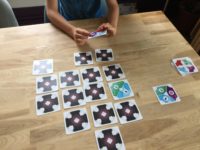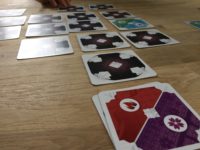- Learning time
- 10 minutes
- First play time
- 30 minutes
Yokai
Designed by: Julien Griffon
Yokai is a game of co-operative play, but hidden information.
The game begins by shuffling the 16 Yokai cards (4 of each suit, or tribe) into a 4 x 4 grid, face-down on the table. Your goal is to rearrange them so that by the time the game ends, all cards of a type are orthogonally adjacent to each other, in an unbroken pattern: you don’t need to keep to the 4×4 shape, but you can’t break any connections, and diagonally adjacent is not considered connected.
How it works is like this: on your turn you can secretly look at two cards, without revealing them to your fellow players. Then you must move one card – it doesn’t have to be one of the cards you’ve seen, but it can be. Finally you must either place a clue card on the grid, or flip a new clue card over. At no time can you identify the colours of any card you know to your fellow players!
The clue cards do two things: they help identify what colour the tribe cards are – or at least, what colour they aren’t – and they function as a timer, because when the clue cards run out, the game is over. But placing them can be risky, partly because although some clue cards have a single colour on them – place a red clue card on a red tribe card, obviously – others have two or three, so as hinted at above, they’re not necessarily definitive. And once a clue card has been placed on a tribe card, that tribe card may not be looked at again!
The other way for the game to end, assuming you still have clues at your disposal, is by any player declaring because they believe the objective has been achieved. Now all the cards are flipped over and if the tribe cards of the same colour are all adjacent, you win! But you can win to varying degrees of success, as the clue cards score points: 1 for successfully used, 2 for flipped but unused, and 5 for any still in the stack!
Joe says
The hardest thing with coop games like this is trying not to break the rules by over-communicating. For me, this often lends the proceedings a fuzzy edge, as when we win, it's hard to feel a real sense of achievement that didn't rely on a little rule-bending. But of course, that's the nature of analogue games - it all depends how seriously you want to take it. Yokai seemed interesting, from the couple of games I played.
The guru's verdict
-
Take That!
Take That!
None, although it's entirely possible to misunderstand or misconstrue what your team-mates are doing.
-
Fidget Factor!
Fidget Factor!
When it's not your turn you need to be watching what's happening with the cards.
-
Brain Burn!
Brain Burn!
Low on rules. High on both memory and deduction.
-
Again Again!
Again Again!
It's not an experience that changes from game to game a great deal - or at all, really. But it's always a challenge,












Sam says
Sometimes a very simple game can be very moreish too, and that's what we found with Yokai - the first play was almost underwhelming, but it got under our skin and we played again and again, sometimes winning but often losing. Why - or when - it works is really down the players, and the shared understandings and nuances of communication you come to. There are basic ones - if a player looks at two cards but separates them, they are usually not the same colour - but there are also more difficult propositions, where you might know what colour all the cards are but need to move one and doing so would (illegally) split the pack. It's important to remember you can't communicate verbally about your knowledge or feelings on the cards, and sticking rigidly to that rule makes it harder - but it does make it far more satisfying when you pull off a win.